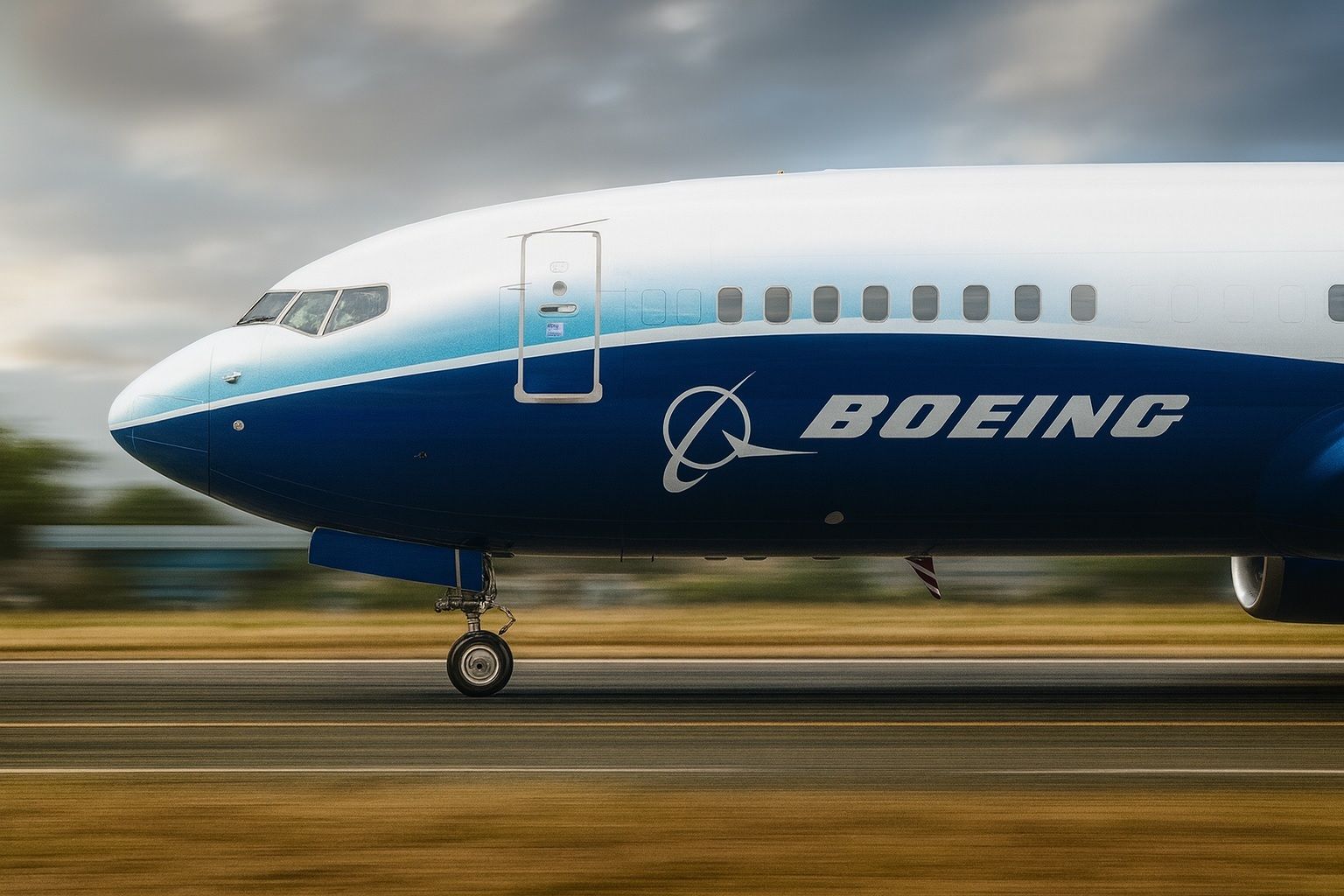Published: November 17, 2025
Boeing stock (NYSE: BA) slipped on Monday even as the company dominated headlines from the opening day of the Dubai Airshow, announced fresh 737 MAX orders from African carriers and unveiled a new unified ecommerce platform for its distribution business. [1]
For investors, November 17 has been one of those “good news, weak price” sessions: the fundamental story clearly improved, yet the share price ended the day modestly lower.
BA stock price on 17 November 2025
As of late trading on Monday, November 17, 2025, Boeing shares were recently changing hands around $191–193 per share, down roughly 1% on the day compared with Friday’s close. [2]
Based on exchange data and delayed feeds:
- Official regular-session close was about $192.7 per share, down around $1.8 (≈0.9%) from Friday’s close near $194.5. [3]
- Recent after-hours trading saw the stock around $191.8, extending the decline to roughly 1.4% versus the prior close.
- Day range (regular session): approximately $192–195. [4]
- Market capitalization is hovering around $147 billion, placing Boeing firmly in large‑cap territory. [5]
- Over the last year, Boeing’s stock has traded between roughly $129 (52‑week low) and $243 (52‑week high), underscoring how volatile the share has been during its recovery. [6]
Independent fundamental analysis estimates Boeing’s one‑year total shareholder return at above 25%, reflecting a strong rebound from last year’s levels, even after recent pullbacks. [7]
Dubai Airshow 2025: Emirates’ mega 777X order steals the show
The single biggest headline for Boeing today came from Dubai. Emirates, already the largest 777X customer in the world, ordered 65 additional 777‑9 aircraft, expanding its 777X order book to 270 jets. [8]
Key details:
- Emirates valued the deal at about $38 billion at list prices, though large customers typically receive significant discounts. [9]
- Deliveries are expected to begin from 2027, reinforcing the long‑term nature of the order book and the airline’s confidence in sustained long‑haul demand. [10]
- The order comes less than three weeks after Boeing acknowledged another delay to the 777X program — yet Emirates still chose to “double down” on the aircraft. [11]
Industry coverage notes that Boeing effectively dominated the opening day of the Dubai Airshow in terms of commercial orders, while Airbus was relatively quiet on large new deals. [12]
For BA shareholders, this 777X top‑up matters because:
- It extends Boeing’s widebody backlog into the 2030s, supporting production planning and long‑term cash flow visibility. [13]
- It sends a public vote of confidence in the troubled 777X program from a flagship customer that has frequently criticized schedule slips, suggesting airlines still view the jet as central to future long‑haul fleets. [14]
At the same time, coverage from Morningstar and others stresses that repeated delays and certification uncertainty remain a key execution risk, even with the order book growing. [15]
New 737 MAX commitments from Africa: Ethiopian Airlines and Air Senegal
Beyond the Emirates widebody splash, Boeing also announced two important 737 MAX deals with African carrierstoday.
Ethiopian Airlines: 11 more 737‑8 jets
Ethiopian Airlines, Africa’s largest carrier, committed to purchase 11 additional 737 MAX aircraft (737‑8) at the Dubai Airshow. [16]
According to Boeing and the airline:
- The jets will expand regional and international routes and support growth at Ethiopian’s Addis Ababa hub. [17]
- Ethiopian now holds the largest Boeing backlog in Africa, underlining a nearly 80‑year relationship between the companies. [18]
The order also carries symbolic weight: Ethiopian was at the center of the 737 MAX crisis after the 2019 crash, so its continued commitment reinforces the narrative that MAX safety concerns, while not forgotten, are no longer blocking fleet plans.
Air Senegal: first 737 MAX order and largest fleet purchase ever
Air Senegal announced a landmark commitment to purchase nine 737‑8 aircraft, its largest‑ever fleet order and first Boeing order since 2004. [19]
Details highlighted in company and news releases:
- The 737‑8 will form the backbone of Air Senegal’s plan to turn Dakar into a regional and intercontinental hub, adding routes to Europe, the Middle East and the Americas. [20]
- Boeing emphasizes the aircraft’s fuel efficiency (around 20% lower fuel burn) and smaller noise footprintcompared with the jets it will replace — important selling points as airlines worldwide face environmental and cost pressures. [21]
Taken together, Ethiopian and Air Senegal’s commitments show that demand for the 737 MAX in growth markets like Africa remains robust, despite Boeing’s recent safety and production challenges. Dow Jones and Morningstar coverage framed the trio of Emirates, Air Senegal and Ethiopian deals as a coordinated Dubai Airshow push by Boeing to reinforce confidence in its product lineup. [22]
Services and aftermarket: Boeing Distribution’s new ecommerce platform
Away from the airshow ramps and static displays, Boeing also moved to strengthen a quieter but highly profitable part of its business: aftermarket parts and services.
On November 17, Boeing announced the launch of a new unified ecommerce website for Boeing Distribution, combining multiple catalogs into a single digital platform. [23]
Key features highlighted by the company and industry coverage:
- Single digital destination for Boeing Distribution’s entire portfolio of parts and services. [24]
- AI‑enhanced search, real‑time inventory visibility and single sign‑on, aimed at reducing friction for airline and MRO customers ordering parts. [25]
- Integration with a modern enterprise resource planning (ERP) system to unify data and improve operational efficiency. [26]
These moves line up with external analysis pointing to Boeing Global Services and parts distribution as a major driver of more stable, recurring, higher‑margin revenue over time. [27]
For BA shareholders, the ecommerce platform won’t move the stock in a single session like a mega aircraft order, but it:
- Strengthens Boeing’s “razor and blades” strategy — sell the aircraft, then earn recurring income from parts, upgrades and digital tools.
- Helps lock in customers through better digital experiences, making it harder for rivals to win aftermarket share.
Defense and space: Patriot seekers and “space stock” exposure
Boeing’s defense and space activities are also part of today’s storyline, even if they draw less attention than Dubai’s flashy widebody deals.
- A Bloomberg Government report notes Boeing expects to triple deliveries of Patriot missile seekers, responding to heightened global demand for air and missile‑defense systems. [28]
- MarketBeat’s “Best Space Stocks To Watch Now” list includes Boeing alongside names such as Rocket Lab, GE Aerospace, AST SpaceMobile and Archer Aviation, underscoring that investors increasingly view Boeing as one of several broad‑based plays on commercial space and defense demand. [29]
While these stories are smaller than the Emirates and 737 MAX headlines, they reinforce a core theme: Boeing’s recovery is not just about commercial jets, but also about expanding high‑margin defense and space revenue streams.
Production reality check: output still capped, competition intensifies
If the order flow is clearly bullish, one reason BA stock may be trading lower today is the gap between orders and execution.
Production constraints and safety focus
In a detailed interview on November 16, Boeing Commercial Airplanes CEO Stephanie Pope told Reuters that the company is focused on stabilizing aircraft production at current levels before pushing to higher output. [30]
Highlights from that discussion:
- Boeing only recently received regulatory clearance to raise 737 production from 38 to 42 jets per month, after a 2024 mid‑air incident exposed safety and quality lapses, including missing bolts in a door plug. [31]
- The company is also ramping the 787 to about eight jets per month and wants to make sure both programs are stable before moving toward higher aims like 47/month for the 737 and 10/month for the 787. [32]
- Boeing is preparing a new “North line” for 737 production at its Everett factory, but it doesn’t plan to use that extra capacity until it is confident the system can handle higher volumes without compromising safety or quality. [33]
The message is clear: quality and regulatory compliance first, volume later. For investors who had hoped for a faster ramp in deliveries (and cash flow), that cautious stance can temper near‑term enthusiasm, even on an order‑heavy day.
Rising competition: COMAC’s C919 in Dubai
Adding to the strategic backdrop, China’s COMAC brought its C919 jetliner to Dubai for its first display outside Asia, positioning it as an eventual competitor to Boeing’s 737 MAX and Airbus’s A320neo family. [34]
Key points from Reuters’ coverage:
- The C919 flew a demonstration at the airshow, signaling Beijing’s ambition to challenge Boeing and Airbus in commercial aviation. [35]
- The aircraft still lacks certification from Western regulators and relies heavily on Western suppliers, so most analysts do not expect COMAC to win significant global market share in the near term. [36]
- Boeing executives publicly welcomed the competition and argued that it pushes the industry to innovate. [37]
For BA stock, COMAC’s presence is more of a long‑term strategic risk signal than an immediate threat, but it adds another reason for investors to watch Boeing’s execution and product roadmap carefully.
Sentiment, valuation and institutional flows
Valuation narratives: still room to run?
Simply Wall St published a fresh valuation piece today describing Boeing’s recent share price as volatile but supported by strong one‑year returns (they cite a 35.2% total shareholder return) and suggesting the stock could still be undervalued by around 20%+ versus its modeled fair value, depending on how quickly earnings and margins recover. [38]
StockAnalysis, meanwhile, estimates Boeing’s market cap around $146 billion and notes its market value has risen by roughly 25–27% over the past year, consistent with the recovery story embedded in many analyst models. [39]
The common thread: the market already prices in a meaningful recovery, but some independent models still see upside if Boeing can:
- Hit higher, stable production rates on 737 and 787
- Certify and ramp the 777X without further major setbacks
- Grow higher‑margin services and defense revenue
Any further safety incidents, supply‑chain shocks or schedule slips could quickly erode that optimism.
What big investors and media voices are doing
Recent filings and commentary show a mixed, but generally constructive, institutional stance:
- Intech Investment Management trimmed its Boeing position, according to a MarketBeat summary published today. [40]
- Rothschild Investment LLC increased its BA holdings by roughly 10.9% in the second quarter, while Pinnacle Financial Group disclosed a new stake, signaling that some long‑term investors are still adding exposure. [41]
- TV personality and fund manager Jim Cramer continues to feature Boeing among the stocks on his radar, noting that “some things are going right” at the company despite a bumpy path. [42]
These moves won’t dictate the share price on their own, but they help shape broader sentiment: Boeing is seen as a high‑beta recovery story, not a finished turnaround.
Why BA stock is down despite strong news
So why did BA stock trade lower on November 17 when the news flow looked overwhelmingly positive?
A few plausible factors:
- Expectations were already high. With Boeing shares up more than 25% over the last year and widely followed as a recovery play, much of the “good news” from Dubai may have been partially priced in. [43]
- Execution over orders. Investors know Boeing’s bottleneck is production, not demand. The Reuters piece emphasizing stabilizing at 42 737s and eight 787s per month before any further ramp is a reminder that cash‑flow acceleration will be gradual. [44]
- Ongoing regulatory and safety overhang. Fresh proposed airworthiness directives for certain 747‑8F and 787 models highlight that regulators are still scrutinizing Boeing’s fleet closely. [45]
- Macro and market mood. Broader U.S. markets traded choppily as investors eyed economic data and major tech earnings this week, creating a risk‑off tone that can weigh on cyclicals like aerospace. [46]
Net result: The fundamental picture improved today, but the risk and execution story didn’t vanish, and the stock traded like a name where good news meets cautious positioning.
Bottom line for Boeing (BA) on November 17, 2025
- Today’s Dubai Airshow headlines were a clear win for Boeing’s order book, led by Emirates’ $38 billion 777X deal and fresh 737 MAX commitments from Ethiopian Airlines and Air Senegal. [47]
- The company is quietly strengthening its high‑margin services business with a unified ecommerce platform for Boeing Distribution, aligning with analyst views that aftermarket and digital services will be key profit engines in the next phase of the turnaround. [48]
- Production, certification and regulatory issues remain the main swing factors for the stock, which helps explain why BA finished the day lower despite the flood of good news. [49]
For investors following Boeing, November 17, 2025 will likely be remembered less for the day’s modest share‑price dip and more as a pivotal moment in rebuilding long‑haul and narrowbody confidence — provided the company can now deliver the jets it has just sold.
This article is for informational and journalistic purposes only and does not constitute investment advice, a recommendation to buy or sell any security, or a substitute for professional financial guidance. Always do your own research and consider your financial situation and risk tolerance before making investment decisions.
References
1. leehamnews.com, 2. finance.yahoo.com, 3. finance.yahoo.com, 4. finance.yahoo.com, 5. www.macrotrends.net, 6. robinhood.com, 7. simplywall.st, 8. boeing.mediaroom.com, 9. timesofindia.indiatimes.com, 10. timesofindia.indiatimes.com, 11. news.bloomberglaw.com, 12. leehamnews.com, 13. investors.boeing.com, 14. news.bloomberglaw.com, 15. www.morningstar.com, 16. boeing.mediaroom.com, 17. investors.boeing.com, 18. investors.boeing.com, 19. boeing.mediaroom.com, 20. investors.boeing.com, 21. www.stocktitan.net, 22. www.morningstar.com, 23. boeing.mediaroom.com, 24. boeing.mediaroom.com, 25. www.stocktitan.net, 26. boeing.mediaroom.com, 27. simplywall.st, 28. news.bgov.com, 29. www.marketbeat.com, 30. www.reuters.com, 31. www.reuters.com, 32. www.reuters.com, 33. www.reuters.com, 34. www.reuters.com, 35. www.reuters.com, 36. www.reuters.com, 37. www.reuters.com, 38. simplywall.st, 39. stockanalysis.com, 40. www.marketbeat.com, 41. www.marketbeat.com, 42. www.insidermonkey.com, 43. simplywall.st, 44. www.reuters.com, 45. www.govinfo.gov, 46. www.benzinga.com, 47. boeing.mediaroom.com, 48. boeing.mediaroom.com, 49. www.reuters.com



![Plug Power (PLUG) Today: Q3 Results Set the Stage for a $275M Liquidity Pivot, Data‑Center Push, and Fresh Analyst Calls [Nov 11, 2025] Plug Power (PLUG) Today: Q3 Results Set the Stage for a $275M Liquidity Pivot, Data‑Center Push, and Fresh Analyst Calls [Nov 11, 2025]](https://ts2.tech/wp-content/uploads/2025/11/Plug-Power-Inc.-PLUG-1-480x384.jpg)



